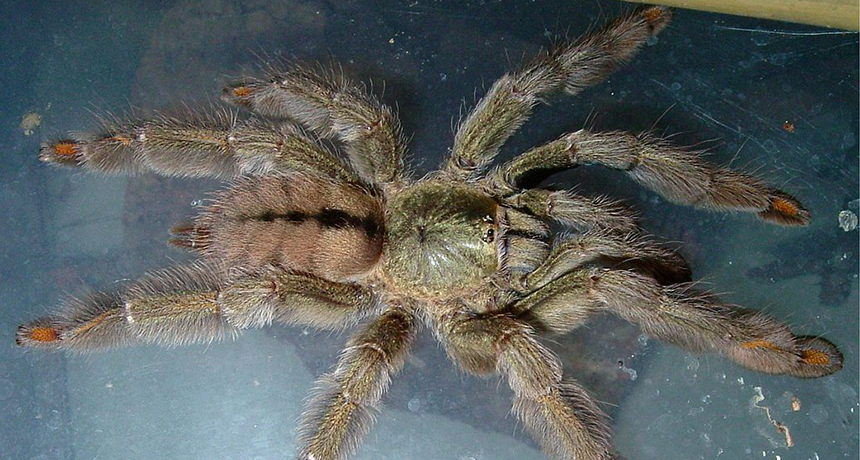Hot Pepper, Hot Spider
Hot peppers and spider venom can cause the same sort of painful burning sensation.

This tarantula, known as the Trinidad chevron, has a hot bite. It hurts so much because it activates the same pain receptors as hot chili peppers.
Wikimedia Commons (CC-BY-SA-3.0-migrated)
By Emily Sohn
Hot peppers and painful spider bites don’t seem to have much in common. Both, however, can cause a similar burning sensation.
New research now suggests a reason why. A chemical in hot peppers and different ones in spider venom happen to activate the same pain sensors in cells.
 |
|
The Trinidad chevron is a West Indian tarantula species that moves quickly and bites when threatened. Its fangs are quite long and can deliver a painful bite.
|
| Copyright © Thomas Schumm/bighairyspiders.com |
The research centered on neurons—special cells that allow the brain and body to communicate with each other. Proteins, called receptors, sit on the surface of neurons and control whether the cells send messages or not. A pain receptor will make a neuron “fire” only when a specific molecule shows up to activate it.
Several years ago, scientists discovered a receptor that’s sensitive to a chemical called capsaicin—the molecule that gives hot peppers their spicy kick. Further studies showed that this receptor and related ones sense both chemicals and temperature.
 |
|
Hot peppers contain a chemical that causes a burning sensation.
|
| iStockphoto.com |
Researchers at the University of California, San Francisco (UCSF) wondered whether these receptors might also respond to spider venom. Scientists know a lot about the molecules in venom that cause shock, paralysis, and death, but they don’t know much about the molecules that cause pain.
To learn more, they studied the venoms of spiders, scorpions, and snails that make you go “ouch.” Experiments showed that the venom of just one West Indian tarantula species, known as the Trinidad chevron, activated the same receptor that’s sensitive to capsaicin. Within that spider’s venom, the scientists found three substances responsible for the effect.
In the lab, the group then tested each of these substances by applying them, one at a time, to mouse neurons in a dish. Some of the mouse neurons were normal and able to fire in response to capsaicin. Others were engineered so that they couldn’t react to capsaicin.
The results showed that the venom molecules activated only the neurons that could also react to capsaicin. And only animals that had the normal neurons felt pain in response to any of the molecules.
 |
|
This Trinidad chevron is about 8 inches long. This tarantula species lives in trees and builds funnel-shaped webs in the rainforests of Trinidad.
|
| M.C.B. Andrade, University of Toronto |
It makes sense that peppers and spiders came up with the same strategy to cause pain, says UCSF researcher David Julius.
“Different organisms have figured out how to tap this site as a way of telling predators, ‘You won’t be comfortable if you mess with me,'” he says.
Future research on the venom-and-veggie sensory pathway might eventually help scientists develop drugs for people to block certain types of pain.—E. Sohn
Going Deeper:
Brownlee, Christen. 2006. Hot, hot, hot: Peppers and spiders reach same pain receptor. Science News 170(Nov. 11):309. Available at http://www.sciencenews.org/articles/20061111/fob5.asp .
LabZone
http://www.sciencenewsforkids.org/articles/20040811/LZActivity.asp







